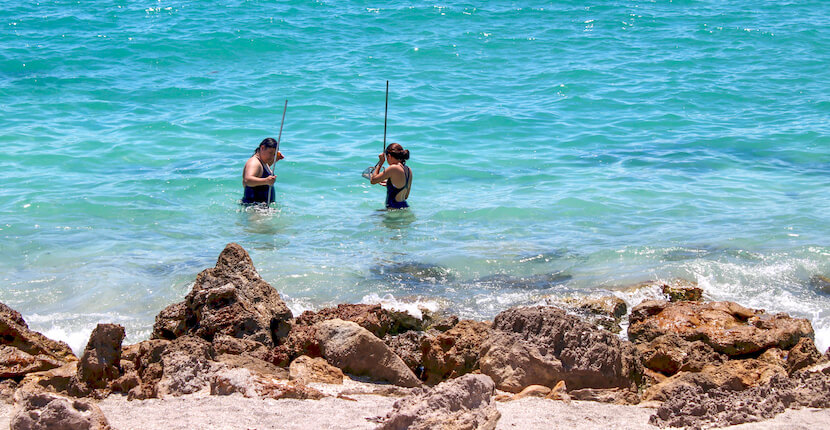When it was submerged millions of years ago, Florida was once home to countless sharks. Although Florida has risen to the surface, shark teeth can still be found on the beaches as a reminder of its glorious past.
One of the most intriguing hobbies is fossil collecting. Sharp, edgy shark teeth are one form of fossil that many people of all ages enjoy collecting. Shark tooth hunting is a thrilling way to spend a beach day. Fortunately, Florida’s beaches are abundant with shark teeth, so you won’t have to go swimming far to find them.
If you enjoy hunting for shark teeth, Florida’s beaches are a must-see. We’ve put together a list of the five greatest shark tooth beaches in Florida where you can go shark tooth hunting! We’re confident you’ll appreciate the five beaches we recommended because each one offers a unique experience.
Venice Beach

The first one on our list of the best beaches to go shark teeth hunting is Venice Beach. This beach is a Florida landmark and is considered the Shark Tooth Capital of the World. Shark teeth, turtle nests, and seashells are among the fossils found on it.
Aside from finding shark teeth, you can also observe dolphins while on the beach because it overlooks the Venice Fishing Pier. There is also free parking, a food concession, picnic spaces, and shelters at the beach.
On the beach, there are two sand volleyball courts where you and your friends can play volleyball. There are also boardwalks to explore. If you enjoy swimming, you’ll appreciate the fact that lifeguards are on duty at the beach from 10 a.m. to 4:45 p.m. every day. Keep in mind that on Venice Beach, camping, fires, alcohol, and tobacco are all prohibited.
Caspersen Beach

Caspersen Beach is approximately 1.5 miles long. Two-thirds of it is left in its natural state to provide additional privacy. Caspersen Beach is quieter and larger than Venice Beach, allowing you to enjoy some quiet alone time.
The quantity of shark teeth at Caspersen Beach has been known for millions of years. A coastal hammock is also available, where you may relax and enjoy the lovely blue and green views along the shore.
Restrooms, a fishing pier, picnic spots, and a playground are all available on the beach. You can also go kayaking, riding, or just walking along the beach and watching the animals. There is a lot of wildlife there, particularly birds of various kinds, which people enjoy photographing.
Fort Clinch State Park

Amelia Island, on Florida’s East Coast, is home to Fort Clinch State Park. The park has beaches with many shark teeth, making it a great place to go shark tooth hunting.
The park also has huge green landscapes where you can feel the breeze of nature. Furthermore, history buffs will love the park’s many historic monuments dating back to the Civil War! Fishing and camping are two other activities available in the park. You can also spend some time there watching the wildlife. It is estimated to include about 250 species, including various birds, raccoons, and squirrels.
Fort Clinch State Park combines nature and history, making it a popular destination for visitors. Keep in mind that the park is only open from 8 a.m. to 5 p.m., and that parking costs $6.
Casey Key

Casey Key is a Florida barrier island. It’s a posh island with a lot of celebs staying there. As a result, there are many exquisite beach villas to admire all around the island.
However, that’s not all there is to Casey Key. Shark teeth can also be found on the island’s shore. Furthermore, because the water is perfectly clear, you may search for shark teeth while taking in the breathtaking scenery.
There are many resorts on Casey Key, but only Nokomis Beach and Jetty Park are open to the public. They’ll be a little busy as a result, but if you venture a little further south, you’ll find secluded locations with various shark teeth.
St. Augustine Beach

St. Augustine Beach is in the city of St. Augustine, on Florida’s northeast coast. You’ll admire St. Augustine’s wonderful heritage as one of America’s oldest cities.
After that, you can spend some time relaxing at the beach. You can go shark tooth hunting there, which will almost certainly be successful.
The water is equally beautiful, and I’m sure resisting the urge to leap into the crystal clear sea will be difficult. You’ll find several food services on the beach to keep your energy up.
How to Identify Shark Teeth ?
You are unlikely to come across a bunch of shark teeth waiting for you. Shark teeth are instead dispersed amid seashells and seaweed, so you’ll have to look hard to discover them.
The teeth of most sharks are triangular. Some shark teeth, on the other hand, are long and needle-like in shape. The tooth will be white if it is brand new. However, because most shark teeth in Florida are fossilized, they will be black or brownish in color. If you want to find a lot of shark teeth, use a sand sifter or a shark tooth sifter to gently dig through the sand.
What’s the Best Time to Go Hunting for Shark Teeth?
The best time to look for shark teeth is a topic of debate. Some claim that it’s preferable to do it while the tide is low when the beach is clear and shark teeth are easier to find.
Others claim that the optimum time to seek shark teeth is during a high tide or right after a storm. They assume that the waves sweep the sand from the coastline and push the fossils deeper into the ocean. This is the most widely held viewpoint.
How to Look for Shark Teeth on the Beach ?
Shark teeth are fairly frequent, and finding them may not necessitate the assistance of a professional. Nonetheless, you may require some guidance in order to locate them; otherwise, you will have to rely entirely on luck.
Step 1: Select the appropriate beach
Shark teeth are plentiful once discovered. They do not, however, exist everywhere. Several beaches are known for sharks and shark teeth-lined shorelines. The Shark Tooth Capital of the World, for example, is Venice Beach in Florida.
The appeal of Venice, Florida as a shark tooth hunting location originates from the city’s lengthy history with sharks. Florida was submerged underwater ten million years ago and was shark territory. They died as the water receded, leaving just their teeth and a few components to fossilize.
Caspersen Beach Park, Venice, and Folly Beach in South Carolina, Wilmington, and Topsail Beach in North Carolina, and Amelia Island and Jacksonville in Florida are among the other beaches to explore.
Locate the spot on the beach where shells and sea rocks are collected. When the sand level is low, it’s referred to as a wash-in area. All of the wave sediments, including shark teeth, end up there.
Step 2: Learn about the different types of marine life.
Many individuals stumble across shark teeth and fail to detect or recognize them, therefore it is important to become familiar with the shapes of shark teeth to avoid missing any. They are glossy black, triangular, and tiny, according to a general description. The ripples on the surface and the gritty, sharp edges are also signs that what you found isn’t just gravel.
Obviously, there are exceptions. The tooth could be shattered, making it non-triangular. If it’s a modern tooth, it could be light in color. As a result of the fossilization process, it just gets darker. If you were lucky enough to come upon a megalodon’s tooth, it could be as big as your palm.
Step 3: Double-check the weather and timing
After a hurricane, many experts advise going to the beach. The waves will uncover new sand layers and push all the shells and shark teeth to the surface layer. This will help you to effortlessly locate the things you seek just beneath your toes.
The tide is another item to keep an eye on. Avoid hunting during high tides, as the shark teeth will be submerged. Low tide gives you a larger field of vision and increases your chances of locating shark teeth.
Step 4: Prepare the Required Tools
Even with the benefits of a storm and a low tide, locating shark teeth may require some digging. The two most important steps are digging and sifting through sand, gravel, seashells, and glass. If you don’t have the correct supplies, they might be exhausting and time-consuming. While combing through the sand for shark teeth, remember to discard any plastic that will litter the beach and harm marine life.
Step 5: Write down your findings.
The age of fossilized shark teeth ranges from 10000 to 75 million years. They are sometimes the last surviving members of extinct species, such as the megalodon shark. This makes them valuable possessions that should be documented.
Always begin by making a list of your findings. If they’re not worthy of a museum display, you may always wear them around your neck to show your gratitude. You may also display your collection for visitors.
Joining the shark tooth annual festival is another entertaining method to document your shark teeth. It’s a gathering of shark tooth hunters who come together to celebrate and display their finds. This takes place in the world’s one and only Shark Tooth Capital.
This heritage, combined with Florida’s beautiful beaches, makes for a lively celebration that you’ll enjoy!
The subject of shark teeth trade is one to keep an eye on. Sharks have a large number of teeth that vary in size. They could have up to 50 rows of teeth in some cases. They also regularly shed their teeth. This is why shark teeth can be found easily on the beach.
Teeth, on the other hand, are sold for thousands of dollars. Sharks are being killed for their teeth and fins. This is not only inhumane, but it also has disastrous consequences for our world, as sharks are now considered endangered. This threat has the potential to completely destroy the food system.
This is why fossilized shark teeth should always be collected or purchased. Also, stay away from completely white, trendy ones.
Conclusion
Shark teeth, like stamps, hold a fascination for collectors. They’re commonly discovered on the beaches of Florida. All you have to do is keep an eye out for them. When looking for shark teeth, several elements can work in your favor.
These include understanding the morphology of shark teeth and hunting for them on beaches where they are usually found. Remember to bring your digging tools so you don’t go home empty-handed.
